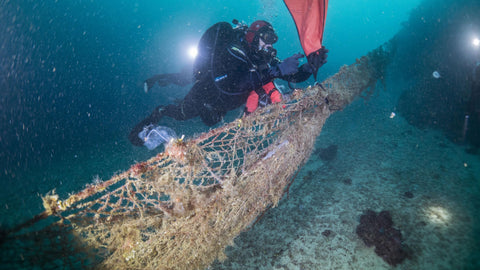One of the major problems in the world today is environmental pollution. In the ocean, this pollution results in particular in the abandonment of fishing equipment in the ocean, in particular fishing nets which cause many ravages within the marine life. Given the magnitude of the problem, volunteers have decided to act by ridding the sea of these "ghost nets" to recycle them into new everyday objects. A bit like eco-responsible swimsuits.

photo credit: Healthy Seas
The ravages of abandoned fishing tackle in the ocean
ROB WILSON runs Ghost Fishing New Zealand (GFNZ) , a Wellington-based voluntary organization dedicated to clearing ghost nets and other debris from coastal waters. While you're enjoying your ethical bathing suit at the beach, he and his team go on clean-up missions most weekends, in response to reports of abandoned nets spotted by divers or boats.
For their rescue operations, the volunteers use the Seafarer II, a commercial fishing boat about fifteen meters long. The nets they pick up are usually full of mud, encrusted with crustaceans, starfish and the skeletons of creatures that have become entangled in the fine nylon filaments of the net. Back at the dock, the divers free as many creatures as possible from the net and throw them back into the water.
Ghost nets, fishing nets lost or abandoned at sea, account for around 10% of all plastic waste in our oceans. Up to 50% of the North Pacific Garbage Patch is ghost fishing gear. Industrial ghost nets can be massive - up to 10 meters long. They drift on ocean currents, continuing to catch fish and other sea life long after their owners have lost or discarded them.
Unless it is incinerated, almost all of the plastic produced to date is still present in the environment. Nylon nets can take centuries to degrade. They kill everything from shrimp and starfish to turtles, sharks, dolphins and whales - at an annual rate that runs into the millions. Small fish are trapped, larger fish try to eat them and are trapped in turn, until the net finally sinks to the ocean floor where it discharges itself after all it has decayed capture. Then it rises to the surface and the whole cycle begins again.
An initiative to recycle sermon nets ghosts of the ocean
Ghost Fishing New Zealand (GFNZ) cooperates with Healthy Seas , an environmental initiative that connects with volunteer divers around the world, and engages the fishing industry to recover ghost nets and develop more sustainable fishing. They are also working with educators so that in the future, closed-loop systems can be applied across the industry, from fish farms to deep-sea fishermen. One of the greatest successes of the organization was to find a market for the salvaged nets. “Before Healthy Seas came along, the nets ended up in landfills, which is not ideal,” says Wilson. "Now they are recycled". And it is thanks to recycling that we can have beautiful collections of sustainable, environmentally friendly swimsuits.
The Healthy Seas initiative, which is doing a lot in the Mediterranean, was co-founded by Aquafil , an Italian nylon manufacturer that builds supply chains that source raw materials from waste rather than directly from industry. petrochemical. The chemical structure of nylon allows it to be recycled endlessly without ever losing its original quality. Aquafil has developed a process that transforms nylon-based products such as old netting and used carpets into a patented premium yarn called ECONYL . These are similar processes that make it possible to obtain very pretty eco-responsible swimsuits.
Since its creation in 2013, Healthy Seas has collected nearly 550,000 tons of fillets from the seas and oceans. But that's only a small fraction of the amount of ghost nets that exist, given that recovery operations depend almost entirely on the efforts of volunteers like Wilson and his crew. You too can make a gesture in favor of the environment by opting for a beautiful ethical swimsuit.


